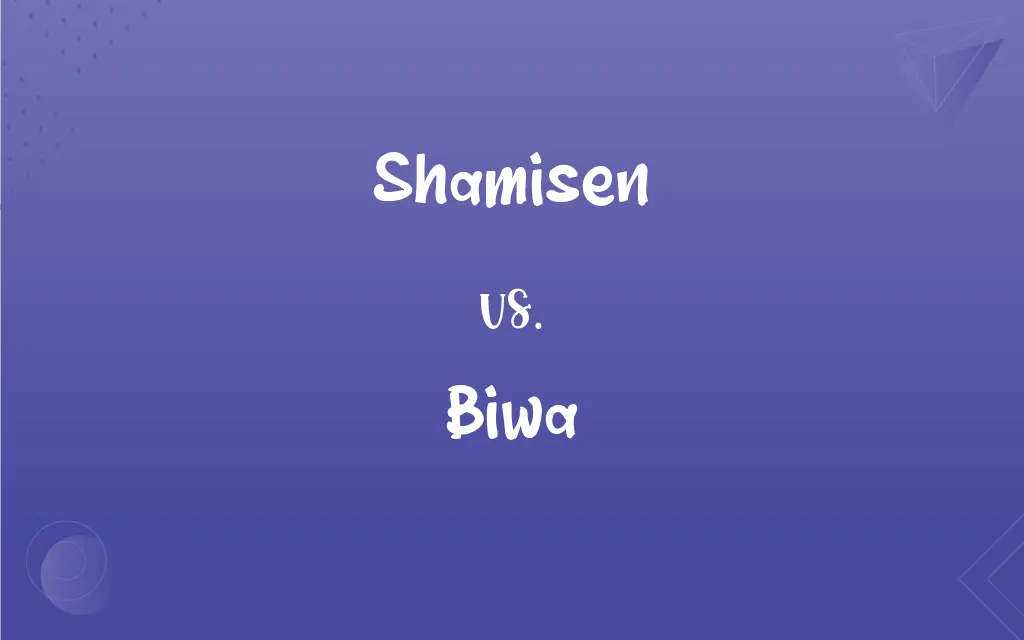Shamisen vs. Biwa: What's the Difference?
By Janet White & Harlon Moss || Updated on March 3, 2024
Shamisen, a three-stringed Japanese instrument, is played with a plectrum, known for its distinct twangy sound. Biwa, on the other hand, is a pear-shaped lute with four to five strings, revered for its deep, resonant tones.

Key Differences
The shamisen and the biwa are both traditional Japanese stringed instruments with a rich history in Japanese music and culture. The shamisen, characterized by its long neck and three strings, is played with a large plectrum called a bachi. It is known for its sharp and percussive sound, which can vary greatly depending on the style of music and the region it comes from. On the other hand, the biwa is a lute-like instrument with a short neck and a pear-shaped body, having four to five strings. It is also played with a plectrum, but the biwa's sound is deeper and more resonant compared to the shamisen. The biwa has a strong association with narrative storytelling, particularly in the Heike Monogatari, an epic account of the Genpei War.
The construction of these instruments also highlights their differences. The shamisen's body, known as the dou, is typically made of wood and covered on both sides with skin, similar to a banjo, which contributes to its distinctive sound. The neck of the shamisen is fretless, allowing for a wide range of pitch bends and expressive playing techniques. In contrast, the biwa's body is solid, and its strings are strung over a series of frets, which allows for more melodic and harmonic playing.
The playing technique for each instrument also differs significantly. Shamisen players often use a variety of striking techniques with the bachi, allowing for a dynamic range of sounds, from soft and delicate notes to sharp and percussive strikes. The instrument's strings can also be pressed down onto the neck to change the pitch, similar to playing a guitar or violin. Biwa players, on the other hand, use the plectrum to pluck and strum the strings, and the use of frets allows for more precise control over the pitch and melody.
Culturally, both instruments hold significant places in Japanese music, but they are often associated with different genres and social contexts. The shamisen is more versatile and can be found in a variety of musical settings, from traditional to contemporary, and even in modern pop and rock music. The biwa, while less commonly featured in contemporary music, remains an important symbol of classical Japanese music and storytelling tradition.
Comparison Chart
Strings
Three
Four to five
ADVERTISEMENT
Shape
Long-necked with a square or rectangular body
Pear-shaped body with a short neck
Sound
Twangy and sharp
Deep and resonant
Playing Technique
Played with a large plectrum (bachi)
Played with a plectrum, involves plucking and strumming
Cultural Association
Kabuki and Bunraku theater, folk music
Narrative storytelling, historical tales
Shamisen and Biwa Definitions
Shamisen
The shamisen is a traditional Japanese instrument with three strings.
The musician skillfully plucked the shamisen's three strings, filling the room with a melodious twang.
ADVERTISEMENT
Biwa
The biwa is a pear-shaped, lute-like instrument with four to five strings.
The biwa player cradled the pear-shaped instrument, ready to begin the ancient tale.
Shamisen
It is played using a large, triangular-shaped plectrum called a bachi.
With each precise strike of the bachi, the shamisen player brought the ancient melody to life.
Biwa
Unlike the shamisen, the biwa has frets, which facilitate melodic play.
The biwa's frets allowed the player to produce precise and melodic tunes, captivating the audience.
Shamisen
The shamisen has a distinctive long neck and a square or rectangular body.
The long neck of the shamisen allows for a wide range of expressive sounds.
Biwa
The biwa is known for its deep, resonant sound, suitable for dramatic narrations.
The biwa's resonant sound filled the room, lending gravity to the historical saga being performed.
Shamisen
This instrument is versatile and used in various genres, from traditional theater to modern music.
The shamisen's versatile sound has made it a staple in both traditional and contemporary Japanese music.
Biwa
Traditionally, the biwa is used for storytelling, especially in narrating epic tales.
The haunting sound of the biwa underscored the dramatic storytelling of epic battles and heroic deeds.
Shamisen
The shamisen's neck is fretless, which allows for unique pitch bends and vibrato effects.
The musician's fingers danced along the shamisen's fretless neck, creating haunting melodies.
Biwa
The biwa is also played with a plectrum, used for strumming and plucking the strings.
The biwa's deep tones resonated through the hall as the plectrum struck its strings.
Shamisen
A Japanese musical instrument resembling a lute, having a very long neck and three strings played with a plectrum.
Biwa
A plucked lute, originating in the classical and traditional music of Japan, characterized by a pear-shaped body and four or five high frets, giving the instrument a distinctively twangy tone.
Shamisen
(musical instrument) A kind of three-stringed Japanese fretless lute.
Shamisen
A Japanese stringed instrument resembling a banjo with a long neck and three strings and a fretted fingerboard and a rectangular soundbox; played with a plectrum
FAQs
What are the main differences between a shamisen and a biwa?
The shamisen has three strings and a long neck, played with a bachi for a sharp sound, while the biwa has four to five strings, a short neck, frets, and is played for melodic and resonant storytelling.
What makes the sound of the biwa unique?
The biwa's deep and resonant sound, produced by its pear-shaped body and plucked strings, makes it unique, especially for dramatic storytelling.
Can the shamisen be used in contemporary music?
Yes, the shamisen is versatile and has been adapted into various genres, including contemporary and modern music styles.
Is the biwa easy to learn for beginners?
Learning the biwa can be challenging due to its unique playing technique and the importance of storytelling, but it is accessible with dedicated practice.
How is the biwa held when played?
The biwa is typically held vertically against the chest or on the lap, and the strings are plucked or strummed with a plectrum.
How is the shamisen played?
The shamisen is played using a large plectrum called a bachi, which is used to strike the strings in various ways to produce different sounds.
What type of music is the biwa associated with?
The biwa is traditionally associated with narrative storytelling, particularly in performing epic tales and historical narratives.
What role does the shamisen play in traditional Japanese theater?
The shamisen is a key instrument in traditional Japanese theater, such as Kabuki and Bunraku, providing musical accompaniment and enhancing the dramatic atmosphere.
Is there a modern resurgence in the popularity of these traditional instruments?
Yes, both the shamisen and the biwa have seen a resurgence in interest, with contemporary musicians exploring new ways to incorporate their sounds into modern music.
Are there different types of shamisen?
Yes, there are several types of shamisen, which vary in size, construction, and sound, tailored to different musical genres and regions.
What genres of music commonly feature the shamisen?
The shamisen is featured in traditional genres like Nagauta, Jiuta, and Min'yo, as well as in contemporary fusion and experimental music.
How does the body shape of the shamisen and biwa affect their sound?
The shamisen's square or rectangular body and skin covering produce a sharp, percussive sound, while the biwa's pear-shaped, wooden body creates deeper, resonant tones.
Are there specific schools or styles of playing the shamisen?
Yes, there are several schools and styles of shamisen playing, each with its own techniques, repertoire, and musical focus.
What cultural significance do the shamisen and biwa hold in Japan today?
Both instruments remain symbols of Japanese cultural heritage, representing traditional music and arts, and continue to be celebrated and preserved for future generations.
What is the historical origin of the shamisen?
The shamisen originated from the Chinese sanxian and was introduced to Japan in the 16th century, where it evolved into its current form.
What is the role of frets on the biwa?
The frets on the biwa allow for more precise control over pitches and facilitate melodic playing, essential for its role in storytelling.
How does the biwa contribute to the storytelling aspect of performances?
The biwa's deep sound and melodic capabilities enhance the emotional and dramatic aspects of storytelling, creating a captivating auditory experience.
What is the significance of the bachi in playing the shamisen?
The bachi is crucial for the shamisen, as its size, shape, and material significantly influence the instrument's sound and the player's technique.
Can the biwa be used in ensemble performances?
While traditionally a solo instrument for storytelling, the biwa can also be part of ensemble performances, adding its unique sound to a broader musical composition.
How do the strings of the shamisen and biwa differ?
The shamisen typically uses silk or nylon strings, known for their sharp, twangy sound, while the biwa's strings, also often made of silk, contribute to its deeper, more melodic tone.
About Author
Written by
Janet WhiteJanet White has been an esteemed writer and blogger for Difference Wiki. Holding a Master's degree in Science and Medical Journalism from the prestigious Boston University, she has consistently demonstrated her expertise and passion for her field. When she's not immersed in her work, Janet relishes her time exercising, delving into a good book, and cherishing moments with friends and family.
Co-written by
Harlon MossHarlon is a seasoned quality moderator and accomplished content writer for Difference Wiki. An alumnus of the prestigious University of California, he earned his degree in Computer Science. Leveraging his academic background, Harlon brings a meticulous and informed perspective to his work, ensuring content accuracy and excellence.































































